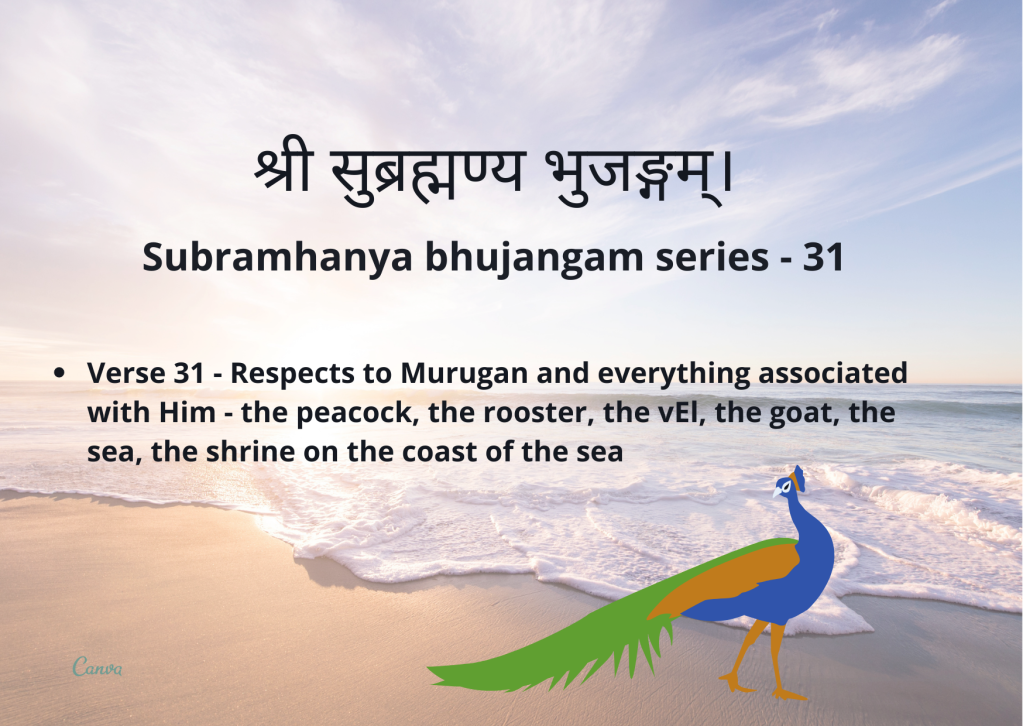We are in the last leg of this work. In this shloka, Adi Shankara offers his salutations and respects to everything that is associated with Murugan.
“I bow to your peacock and also to your spear (vEl); I bow to the goat and your rooster; I offer obeisance to the sea and the temple at its shore; Once again, Skanda! I bow to you and my salutations to you.”
नमः केकिने शक्तये च अपि तुभ्यम् (namah kEkinE shaktayE ca api tubhyam)
Salutation – for the peacock – for the shakti vEl – and – also – to you/your
नमः छाग तुभ्यम् नमः कुक्कुटाय (namah chAga tubhyam namah kukkutAya)
Salutation – goat – your – salutation – for the cock/rooster
नमः सिन्धवे सिन्धुदेशाय तुभ्यम् (namah sindhavE sindhudEshAya tubhyam)
Salutation – for the sea – for the region near the sea (temple) – your
पुनः स्कन्दमूर्ते नमस्ते नमोस्तु (punah skandamUrtE namastE namOstu)
Again – Skanda mUrti – (I) bow to you – salutations (to you)

kEkA is the term for the peacock’s cry in Sanskrit. That whose cry is called kEkA is kEkin or the peacock. In Sanskrit, like some other languages, the nouns are formed after or based on the verbs. Although, peacock is very commonly referred as mayUrah, there are also many other terms like kEkin, shikhin, etc, named after some characteristics.
The reference to the goat (namah chAga tubhyam) in this shloka is not a very common thing, at least to me, as this was the first time I came across this. Sage nAraDA once conducted a yajna for the welfare of the worlds. As some of the saints uttered the vEda mantras wrongly or mispronounced, a ferocious goat came out of the agni and it started attacking everyone. Sage nAraDA prayed to Lord Murugan and He finally controlled the goat and made it as His mount. The goat is said to be His first mount or the vAhanA before peacock. It is interesting to note that the Goat came out of the fire because of mispronounced mantras and is also believed that it attacked all those sages who did not understand the vedas or were not serious enough to properly pronounce the mantras. But Lord Murugan ultimately saved them all. This shows that the intention and bhakti is more important than the understanding of vedas, mantras or shlokas. Even the God doesn’t mind if the words are mispronounced. The intention of nAraDa and other sages for conducting that yajna was welfare of the world and Murugan saved and blessed them just for their pure intentions even though there were some (believed) shortcomings with respect to the understanding of mantras or their pronunciation. Of course, it is always good to try to understand the meaning of a shloka and to get the pronunciation right. Nothing should stop us from aspiring to learn more. At the same time, this shouldn’t stop us either from praying or chanting. The good intention and pure devotion are better reasons to pray and chant shlokas.
As Murugan destroyed all the demons and evil forces, Surapadman was the only one left and finally he took the form of a mango tree. Lord Murugan split it open into two and one part became the rooster and it became the emblem in Murugan’s flag and the other part took the form of a peacock and it became Murugan’s mount.
The vEl or the spear was given to Murugan by none other than the lOkamAtha and His Mother, parAshakti Herself to destroy sUrapadman. Adi Shankara offers his salutations to the tiruchendur shrine that houses Lord Murugan and also bows down to the sea itself because of its association with the temple and hence Murugan.
When we like or respect someone, we generally tend to like or respect the many things associated with that person. Similarly, Adi Shankara doesn’t just offer his salutations to Murugan, but also to many other things associated with Murugan, like His rooster, peacock, goat, vEl, the sea and the shrine on the coast of the sea. And he couldn’t stop bowing down or paying his respects just once, he says that he bows to Murugan again and again and that all his salutations shall always be towards Him.
“சவதமொடு தாண்டித் தகர் ஊர்வாய்” என்று அருணகிரிநாதர், அவசியமுன் வேண்டி எனத் தொடங்கும் திருமுருகன்பூண்டித் திருப்புகழில், நாரதர் நடத்திய வேள்வித் தீயிலிருந்து வெளி வந்த செம்மறி ஆட்டையும் அதனை அடக்கி முருகன் தன் வாகனமாகக் கொண்டதையும் பாடுகிறார்.
LikeLiked by 1 person